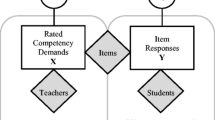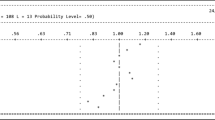Abstract
With regard to the moderate performance of German students in international large-scale assessments, one branch of German science education research is concerned with the construction and evaluation of competence models. Based on the theory-driven definition of competence levels, these models imply a correlation between the complexity of a question or a problem, its difficulty and the cognitive demands that are required to answer or solve it. The aim of the study was to apply two competence models in order to analyse the complexity of questions that chemistry teachers use to promote learning in class as well as to compare the results of this analysis. Two model-based coding schemes were constructed and evaluated on the basis of interrater reliability before analysing the teacher questions in 40 chemistry lessons. The results show that between 60 and 65 % of the questions refer to low complexity levels. Although there is a considerable correspondence between the results (69.2 %), neither model can be considered as redundant. These findings are discussed with regard to the level and the development of students’ skills in science.

Similar content being viewed by others
References
Aebli, H. (1980). Denken: das Ordnen des Tuns [Thinking: Organizing Actions]. Stuttgart, Germany: Klett-Cotta.
American Association for the Advancement of Science (2001). Atlas of scientific literacy. Washington, DC: AAAS.
Ausubel, D. P. (1968). Educational psychology: A cognitive view. New York, NY: Holt, Rinehart & Winston.
Baumert, J., Artelt, C., Klieme, E., Neubrand, M., Prenzel, M., Schiefele, U., ... Weiss, M. (Eds.). (2002). PISA 2000 - die Länder der Bundesrepublik Deutschland im Vergleich. [PISA 2000—comparing the Federal States of Germany] (OECD, PISA). Opladen, Germany: Leske + Budrich.
Bernholt, S. (2010). Kompetenzmodellierung in der Chemie - Theoretische und empirische Reflexion am Beispiel des Modells hierarchischer Komplexität[Modelling competence in chemistry—Theoretical and empirical reflexion through the example of the model of hierarchical complexity]. Berlin, Germany: Logos Verlag.
Bernholt, S. & Parchmann, I. (2011). Assessing the complexity of students’ knowledge in chemistry. Chemistry Education Research and Practice, 12, 167–173. doi:10.1039/C1RP90021H.
Bernholt, S., Parchmann, I., & Commons, M. L. (2009). Kompetenzmodellierung zwischen Forschung und Unterrichtspraxis [Modelling scientific competence between research and teaching practice]. Zeitschrift für Didaktik der Naturwissenschaften, 15, 217–243. Retrieved from: http://www.ipn.uni-kiel.de/zfdn/pdf/15_Bernholt.pdf.
Bernholt, S., Neumann, K., & Nentwig, P. (Eds.). (2012). Making it tangible: Learning outcomes in science education. Münster, Germany: Waxmann.
Biggs, J. B. (1999). Teaching for quality learning at university. Buckingham, England: SRHE and Open University Press.
Bos, W. & Tarnai, C. (1999). Content analysis in empirical social research. International Journal of Educational Research, 31, 659–671. doi:10.1016/S0883-0355(99)00032-4.
Bransford, J. D., Brown, A. L., Cocking, R. R., Donovan, M. S. & Pellegrino, J. W. (2000). How people learn: Brain, mind, experience, and school [Expanded edition]. Washington, DC: National Academies Press.
Cohen, J. (1960). A coefficient of agreement for nominal scales. Educational and Psychological Measurement, 20(1), 37–46. doi:10.1177/001316446002000104.
Commons, M. L. (2008). Introduction to the model of hierarchical complexity and its relationship to postformal action. World Futures: The Journal of Global Education, 64, 305–320. doi:10.1080/02604020802301105.
Commons, M. L., Trudeau, E. J., Stein, S. A., Richards, F. A., & Krause, S. R. (1998). Hierarchical complexity of tasks shows the existence of developmental stages. Developmental Review, 18, 237–278. doi:10.1006/drev.1998.0467.
Field, A. (2009). Discovering statistics using SPSS. Los Angeles, CA: Sage.
Fleiss, J. L. (1981). Statistical methods for rates and proportions. New York, NY: John Wiley.
Geller, C., Neumann, K., Boone, W. J., & Fischer, H. E. (2014). What makes the Finnish different in science? Assessing and comparing Students’ science learning in three countries. International Journal of Science Education, 36(18), 3042–3066. doi:10.1080/09500693.2014.950185.
Glemnitz, I. (2007). Vertikale Vernetzung im Chemieunterricht. Ein Vergleich von traditionellem Unterricht mit Unterricht nach Chemie im Kontext. [Vertical crosslinking in chemistry. A comparison of traditional chemistry lessons and lessons following Chemie im Kontext]. Berlin, Germany: Logos Verlag.
Helaakoski, J. & Viiri, J. (2014). Content and content structure of physics lessons and students’ learning gains: Comparing Finland, Germany and Switzerland. In H. E. Fischer, P. Labudde, K. Neumann, & J. Viiri (Eds.), Quality of instruction in physics. Comparing Finland, Germany and Switzerland (pp. 93–110). Münster, Germany: Waxmann.
Kauertz, A. (2008). Schwierigkeitserzeugende Merkmale physikalischer Leistungstestaufgaben [Difficulty generating characteristics of physical performance test tasks]. Berlin, Germany: Logos.
Klieme, E., Avenaruis, H., Blum, W., Döbrich, P., Gruber, H., Prenzel, M., ... Vollmer, H. J. (2003). Zur Entwicklung nationaler Bildungsstandards. Eine Expertise [The development of educational standards. An expert report]. Berlin, Germany: BMBF.
Klieme, E., Maag-Merki, K., & Hartig, J. (2007). Kompetenzbegriff und Bedeutung von Kompetenzen im Bildungswesen [The notion of competence and the significance of competences in the educational system]. In J. Hartig & E. Klieme (Eds.), Möglichkeiten und Voraussetzungen technologiebasierter Kompetenzdiagnostik. Eine Expertise im Auftrag des Bundesministeriums für Bildung und Forschung (pp. 5–15). Berlin, Germany: BMBF.
KMK (Hrsg.) (2004). Bildungsstandards im Fach Chemie für den Mittleren Schulabschluss (Jahrgangsstufe 10) [Educational standards in chemistry]. Berlin, Germany: Author. Retrieved from http://www.kmk.org/fileadmin/veroeffentlichungen_beschluesse/2004/2004_12_16-Bildungsstandards-Chemie.pdf (30.09.2014).
Knobloch, R. (2011). Analyse der fachinhaltlichen Qualität von Schüleräußerungen und deren Einfluss auf den Lernerfolg. Eine Videostudie zu kooperativer Kleingruppenarbeit. [Analysis of the content related quality of students’ statements and their impact on learning outcomes]. Berlin, Germany: Logos Verlag.
Koeppen, K., Hartig, J., Klieme, E., & Leutner, D. (2008). Current issues in competence modeling and assessment. Zeitschrift für Psychologie/ Journal of Psychology, 6(2), 61–73. doi:10.1027/0044-3409.216.2.61.
Köller, O. & Parchmann, I. (2012). Competencies: The German notation of learning outcomes. In S. Bernholt, K. Neumann, & P. Nentwig (Eds.), Making it tangible. Learning outcomes in science education (pp. 151–172). Münster, Germany: Waxmann.
Lau, A. (2011). Passung und vertikale Vernetzung im Chemie- und Physikunterricht [Matching and vertical crosslinking in chemistry and physics lessons]Matching and vertical crosslinking in chemistry and physics lessons]. Berlin, Germany: Logos Verlag.
Liu, X. (2009). Linking competencies to opportunities to learn. New York, NY: Springer.
McClelland, D. C. (1973). Testing for competence rather than for “intelligence”. American Psychologist, 28, 1–14. Retrieved from: http://www.lichaoping.com/wp-content/ap7301001.pdf.
Miller, G. A. (1956). The magical number seven, plus or minus two: Some limits on our capacity for processing information. Psychological Review, 63(2), 81–97. doi:10.1037/h0043158.
Müller, C. T. & Duit, R. (2004). Die unterrichtliche Sachstruktur als Indikator für Lernerfolg – Analyse von Sachstrukturdiagrammen und ihr Bezug zu Leistungsergebnissen im Physikunterricht [The content structure as an indicator for learning outcomes—the analysis of content structure diagrams and their relation to learning outcomes in physics]. Zeitschrift für Didaktik der Naturwissenschaften, 10, 147–161. Retrieved from: ftp://ftp.rz.uni-kiel.de/pub/ipn/zfdn/2004/7.Mueller_Duit_147-162.pdf.
Neumann, I. (2011). Beyond physics content knowledge: Modeling competence regarding nature of scientific inquiry and nature of scientific knowledge. Berlin, Germany: Logos Verlag.
Neumann, K., Kauertz, A., Lau, A., Notarp, H. & Fischer, H. E. (2007). Die Modellierung physikalischer Kompetenz und ihrer Entwicklung [Modelling Competence and its Development in Physics]. Zeitschrift für Didaktik der Naturwissenschaften; Jg. 13, 103--123.
Neumann, K., Fischer, H. E., & Kauertz, A. (2010). From PISA to educational standards: The impact of large-scale assessments in Germany. International Journal of Science and Mathematics Education, 8, 545–563. doi:10.1007/s10763-010-9206-7.
Päßler, A. (2011). Analyse von Vernetzung im Chemieunterricht anhand des Modells der hierarchischen Komplexität [Analysis of networking in the teaching of chemistry on the basis of the model of hierarchical complexity][ Unpublished master's thesis]. Humboldt-Universität zu Berlin, Germany.
Pellegrino, J. W., Chudowski, N., & Glaser, R. (Eds.). (2001). Knowing what students know. Washington, DC: National Academies Press.
Prenzel, M., Baumert, J., Blum, W., Lehmann, R., Leutner, D., Neubrand, M., ...Schiefele, U. (Eds.). (2005). PISA 2003: Der zweite Vergleich der Länder in Deutschland – Was wissen und können Jugendliche? [The second comparison of the German states—What do students know?]. Münster, Germany: Waxmann.
Rimmele, R. (2002). Videograph. Multimedia-Player zur Kodierung von Videos[ Videographer. Multimedia player to encode videos]. Kiel, Germany: IPN.
Schecker, H. & Parchmann, I. (2007). Standards and competence models: The German situation. In D. Waddington, P. Nentwig & S. Schanze (Eds.), Standards in science education (pp. 147–164). Münster, Germany: Waxmann.
Songer, N. B. & Linn, M. C. (1991). How do students’ views of science influence knowledge integration? Journal of Research in Science Teaching, 28(9), 761–784. doi:10.1002/tea.3660280905.
Stigler, J. W., Gonzales, P., Kawanaka, T., Knoll, S., & Serrano, A. (1997). The TIMSS videotape classroom study: Methods and Findings from an exploratory research project on eighth-grade mathematics instruction in Germany, Japan, and the United States. Washington, DC: U. S. Department of Education National Center for Education Statistics.
Sweller, J. (1994). Cognitive load theory, learning difficulty, and instructional design. Learning and Instruction, 4, 293–312. doi:10.1016/0959-4752(94)90003-5.
Tiemann, R. (1999). Analyse individueller Wissensstrukturen im Kontext Chemie mit Hilfe eines neuen Mapping-Verfahrens [Analysing the individual knowledge structures in the context of chemistry using a new mapping procedure]. Münster, Germany: LIT.
Wadouh, J. (2007). Vernetzung und kumulatives Lernen im Biologieunterricht der Gymnasialklasse 9 [Crosslinking and cumulative learning in 9th grade biology classes]. Essen: Universität Duisburg-Essen. Retrieved from: http://duepublico.uni-duisburg-essen.de.
Walpuski, M., Ropohl, M., & Sumfleth, E. (2011). Students’ knowledge about chemical reactions—development and analysis of standard-based test items. Chemistry Education Research and Practice, 12(2), 174-183. doi:10.1039/c1rp90022f.
Weinert, F. E. (2001). Concept of competence: A conceptual clarification. In D. S. Rychen & L. H. Salganik (Eds.), Defining and selecting key competencies (pp. 45–65). Seattle: Hogrefe & Huber.
White, R. W. (1959). Motivation reconsidered: The concept of competence. Psychological Review, 66(5), 297–333.
Wirtz, M. & Caspar, F. (2002). Beurteilerübereinstimmung und Beurteilerreliabilität [Interrater Agreement and Interrater Reliability]. Göttingen, Germany: Hogrefe.
Author information
Authors and Affiliations
Corresponding author
Rights and permissions
About this article
Cite this article
Nehring, A., Päßler, A. & Tiemann, R. The Complexity of Teacher Questions in Chemistry Classrooms: an Empirical Analysis on the Basis of Two Competence Models. Int J of Sci and Math Educ 15, 233–250 (2017). https://doi.org/10.1007/s10763-015-9683-9
Received:
Accepted:
Published:
Issue Date:
DOI: https://doi.org/10.1007/s10763-015-9683-9




